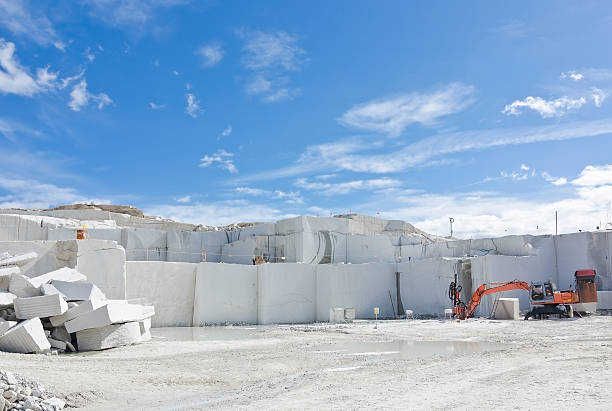A Trip Via Granite Quarries in South Africa: Unveiling Nature's Creativity
A Trip Via Granite Quarries in South Africa: Unveiling Nature's Creativity
Blog Article
Unearthing the Rich Background and Lasting Practices of Granite Quarrying
As we depend on the precipice of uncovering the complex tapestry of granite quarrying, a trip via time exposes not just the physical act of removing rock yet also the social and historic value woven right into the really material of this method. From the ancient origins that laid the structure for modern-day quarrying techniques to the lasting techniques that are forming the future of this sector, each sculpt mark on granite surfaces informs a story waiting to be unearthed (granite quarries in south africa). The tradition of granite quarrying extends much past simple extraction; it is a testimony to human ingenuity, durability, and the enduring allure of this majestic rock
Old Beginnings of Granite Quarrying
Going back to ancient people, the technique of quarrying granite has been an essential part of human background and architectural improvement. The earliest evidence of granite quarrying dates back to ancient Egypt, where large pyramids and detailed sculptures were crafted from this durable rock. The Egyptians made use of primitive tools to draw out granite blocks from quarries, showcasing the relevance of this material in their monumental constructions.
Moving on in history, the Greeks additionally made considerable payments to the quarrying of granite. The Greeks utilized granite in various building wonders, such as temples and statues, demonstrating their ability in shaping and sculpting this hardy rock. The Romans additionally improved the techniques of quarrying granite, using advanced tools like blades and hammers to essence and form granite for their iconic frameworks.
Through the centuries, the practice of quarrying granite has progressed, with modern innovations boosting effectiveness while keeping the classic appeal of this all-natural rock - granite quarries in south africa. From old human beings to modern builders, the legacy of granite quarrying remains to shape our world
Advancement of Quarrying Strategies
The advancement of quarrying strategies has actually been noted by a constant progression towards greater performance and accuracy in removing granite. From the basic methods employed by our forefathers to the advanced innovations utilized in modern quarrying procedures, the market has undergone substantial innovations. Early quarrying methods involved manual work with standard tools such as chisels, hammers, and wedges to remove granite blocks from the planet. As worlds progressed, strategies like fire-setting and primitive dynamites were introduced to promote the removal process.
In more recent times, the development of equipment changed the quarrying industry, making it possible for faster removal prices and boosted efficiency. Technologies such as ruby cable saws, high-pressure water jets, and pneumatically-driven drills have ended up being conventional in modern quarries, enabling specific cutting and decreased waste. In addition, developments in computer-controlled tools and 3D modeling have actually enhanced quarrying procedures, leading to very little ecological influence and enhanced sustainability practices. As the need for granite remains to rise, the advancement of quarrying strategies remains important to conference market requires efficiently and sustainably.
Cultural Importance of Granite
Granite holds an extensive cultural importance throughout various human beings due to its enduring existence in building masterpieces and respected monoliths. From the stunning pyramids of Egypt to the elaborate carvings of the Angkor Wat temple in Cambodia, granite has been a product the original source of selection for sharing magnificence and durability in cultural heritage. In ancient Rome, granite columns adorned holy places and public structures, representing stamina and permanence. The cultural significance of granite expands past its physical qualities; it embodies durability, stability, and timelessness, making it an icon of sustaining traditions and traditions.

Sustainable Practices in Quarrying
Among the abundant visit site background of granite quarrying and its cultural significance exists a growing emphasis on lasting methods within the market. As environmental recognition and problems regarding resource depletion have actually increased internationally, the quarrying field has actually increasingly welcomed lasting methods to decrease its effect on the setting and surrounding areas.

In addition, recovery and recovery of quarry sites post-extraction are essential to sustainable methods. By bring back quarried locations to an all-natural or advantageous state, such as creating wild animals habitats or entertainment rooms, quarriers can offset the ecological impact of their operations and add positively to the neighborhood ecological community.
Legacy of Granite Quarrying
With a historic background steeped in Get the facts craftsmanship and industrial progress, what enduring influence has granite quarrying left on the landscape of modern-day society? The heritage of granite quarrying goes beyond simple extraction techniques; it has shaped building marvels, urban landscapes, and cultural heritage worldwide. The durable nature of granite has actually made it a recommended choice for monuments, buildings, and framework, standing as a testimony to the skill and artistry of quarry employees throughout generations.
Additionally, the economic footprint of granite quarrying can not be ignored. The industry remains to supply employment possibilities and drive neighborhood economies in areas where granite extraction prevails. It has actually likewise spurred technological developments in quarrying strategies and devices, leading to much more efficient and lasting techniques.
In terms of sustainability, the heritage of granite quarrying includes efforts to minimize environmental effects via improvement tasks and responsible resource monitoring. By balancing financial interests with ecological stewardship, the sector strives to make sure that future generations can remain to gain from this long-lasting natural source.
Conclusion

Report this page